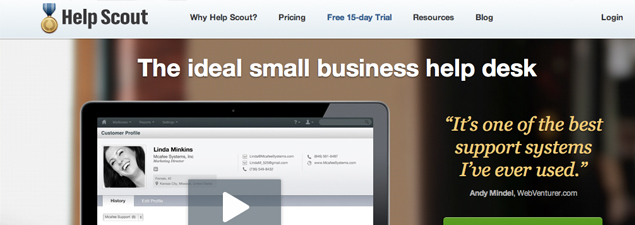The 3 Biggest Misconceptions Small Business Owners Have About Customer Service
Posted on October 3rd, 2012

One thing about the customer service space that really irks me is this obsessive emphasis on “best practices” and generic tips… all of them backed by almost no data.
That’s a shame, because the data is definitely out there, in the form of consumer research studies and social psychology books & experiments.
While most of the advice is still solid, it’s always a good idea to confirm your intuitions with solid intel, just like Hively allows you to gather feedback from your email support efforts.
Below I’ve outlined the 3 biggest misconceptions in this highly important aspect of your business, and if you want to argue about it, get prepared: I’ve got research on my side! 🙂
1.) Myth: Your Customers Want “In and Out” as Fast as Possible
Don’t get me wrong, there are times when it is appropriate to “get out of the way” of your customers.
I like being a self-sufficient person and I don’t always need to get a hold of someone from support, especially if I’m trying to learn something about the product.
One example comes from premium WordPress theme sellers like DIYThemes, who offer a huge tutorial section for learning their software at your own pace.
That being said, the data shows that there are times when trying to maximize speed and minimize customer interaction can go horribly wrong.
Strangely enough, this lesson comes to us from research that analyzed convicted felons!
The research (found in the book Sway) examined how these felons felt about the “fairness” of their sentencing in relation to the crime committed.
Outside of the obvious (those with harsher sentences deemed they were “unfair”), there was a very interesting tidbit that the book pointed out: those felons who had spent more face-to-face time with their lawyer were far more likely to rate their sentence as “fairer” than those who didn’t spend as much time with their lawyer.
Woah!
The Brafman brothers, authors of Sway, asserted that:
“…Although the outcome might be exactly the same [in length of sentence], when we don’t get to voice our concerns, we perceive the overall fairness of the experience quite differently.”
In similar research, it was found that while most patients who are injured during a procedure do not sue their doctors, those who were far most likely to sue were those who felt their doctor “rushed” their treatment or didn’t spend enough time with them.
Customers value attention in a world that promotes efficiency over everything else.
Letting your customers know that you appreciate them takes more than a “thank you” or a pleasant demeanor: actions speak louder than words, and attentive, personalized service says volumes.
Don’t try to get your customers in-and-out as fast as possible, make sure they leave as satisfied as possible.
2.) Myth: Customer Feedback is Not Useful for Innovation
Numerous quotes on the importance of innovation coming from the company (and not the customer) can be found from some pretty prominent names.
Take Steve Jobs often cited quote:
“It’s really hard to design products by focus groups.
A lot of times…people don’t know what they want until you show it to them.”
Or the one from Henry Ford (even though he probably didn’t say it):
“If I had asked people what they wanted, they would have said faster horses.”
While trying to radically innovate while listening to feedback from your average customer isn’t always optimal, to deny that your customers can’t do many things better than you is just absurd.
In fact, there are plenty of notable examples of customers playing an integral role in company innovation.
My favorite examples come in the following two forms…
The first is a broad look at innovation from MIT’s Eric von Hippel. In his research, he analyzed 1,193 commercially successful innovations across nine industries.
He found that 737 of those (60%) came from customers!
Another more specific example comes to us from the multinational conglomerate 3M.
In the 90’s, 3M’s Medical-Surgical Markets Division was in a big slump, and they needed to make changes fast. In order to inspire some more creative thinking, they organized a “lead user” (superstar customer) team to help with innovations in addition to their in-house staff.
Want to compare the results yourself?
- User-lead innovations had an average revenue of $146 million dollars (in 5 years)
- Internally generated innovations had an average revenue of $18 million (for the same time-span)
Yikes, customers win again!
This research is important to keep in mind because many fantastic businesses are founded and flourish just by solving customer problems.
As it turns out, customers are pretty good at telling you what those problems are and in helping you innovate to deliver solutions, so don’t forget it.
3.) Myth: Winning Over Customers Takes Big Expenditures
According to Cialdini’s research, the social construct of reciprocity is one that is pervasive in all societies.
The process of reciprocity is doing favors for others and creating goodwill with people so that they view you favorably in return. Most businesses understand this practice (at least I hope so!), but too many think that it’s all about the expense.
In a classic study by psychologist Norbert Schwarz, he found that as little as 10 cents (this was in 1987) was enough to change the outlooks of participants who found the money by surprise.
In a later interview, Schwarz would later sum up this phenomenon as such:
It’s not the value of what you find. It’s that something positive happened to you.
Simple enough right?
In another great example, a company called Sweetgreen regularly places gift-cards under bicycle seats when it’s raining and near parking tickets by expired meters, just to brighten people’s day.
That’s an example of a “frugal WOW” in action; dazzling customers with caring service that doesn’t cost you a whole lot.
With this info in hand, you need to re-think any pricey programs you have in mind and focus on really surprising customers with creative acts of kindness that generate goodwill for a fraction of the cost.
Your Turn!
What did you think of some of this research?
Let me know in the comments, I’ll see you there!
About the Author: Gregory Ciotti is the marketing guy at Help Scout, the invisible help desk that turns email support into a personalize & painless process for you and your customers. Get more customer insights from the Help Scout blog or from our free e-book.
Be the first to comment!
